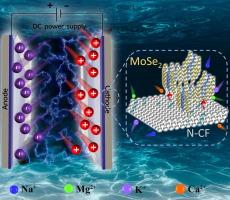Configuration of 3D hydrangea-like MoSe2@N-doped carbon nanoflowers with synergistic functional regulation for highly efficient and selective capacitive deionization
IF 8.1
1区 工程技术
Q1 ENGINEERING, CHEMICAL
引用次数: 0
Abstract
Transition-metal diselenides (TMDs) are promising materials for capacitive deionization (CDI) technology due to their high theoretical storage capacity and reversible intercalation/deintercalation behavior. However, drawbacks of TMDs like low conductivity, interlayer self-stacking and volume expansion severely impede ion migration, undermine the structural stability, and limit the accessibility of active sites, ultimately leading to unsatisfactory CDI performance. Herein, we elaborately designed a three-dimensional hydrangea-like MoSe2@N-doped carbon nanoflowers (MoSe2@N-CF) composite to enhance the efficiency and selectivity of cation capture. In this configuration, N-CF can not only serve as the growth substrate to prevent the aggregation of MoSe2 nanosheets and enhance the conductivity, but also effectively increases the interlayer spacing of MoSe2 in the molecules level. Meanwhile, the unique pseudocapacitive intercalation behavior of MoSe2 provides abundant active sites for cation storage and fast ion diffusion kinetics for ion transfer. Benefited from the synergistic functional regulation of MoSe2 and N-CF, the MoSe2@N-CF electrode demonstrates a remarkable specific capacitance (217.3 F g−1), reduced ion diffusion resistance, and superior electrochemical stability. The asymmetrical CDI cell (AC//MoSe2@N-CF) presents excellent desalination capacity (40.83 mg g−1), rapid desalination rate (6.93 mg g−1 min−1), and demonstrates a 90 % retention rate (from 16.42 mg g−1 to 14.78 mg g−1) over 35 CDI cycles. Additionally, the MoSe2@N-CF electrode exhibits unique ion selectivity in multi-ion solutions, which reflects the combined influence of intercalation effect and electric double-layer effect arising from the distinct functional structures within the composite material, where their relative contributions vary with solution concentration. Density functional theory calculations further validate the ion selectivity mechanism based on ion diffusion energy. This work offers valuable insights into leveraging unique structural characteristics of pseudo-capacitive intercalation material and carbon-based material, advancing the development of CDI.

求助全文
约1分钟内获得全文
求助全文
来源期刊

Separation and Purification Technology
工程技术-工程:化工
CiteScore
14.00
自引率
12.80%
发文量
2347
审稿时长
43 days
期刊介绍:
Separation and Purification Technology is a premier journal committed to sharing innovative methods for separation and purification in chemical and environmental engineering, encompassing both homogeneous solutions and heterogeneous mixtures. Our scope includes the separation and/or purification of liquids, vapors, and gases, as well as carbon capture and separation techniques. However, it's important to note that methods solely intended for analytical purposes are not within the scope of the journal. Additionally, disciplines such as soil science, polymer science, and metallurgy fall outside the purview of Separation and Purification Technology. Join us in advancing the field of separation and purification methods for sustainable solutions in chemical and environmental engineering.
 求助内容:
求助内容: 应助结果提醒方式:
应助结果提醒方式:


